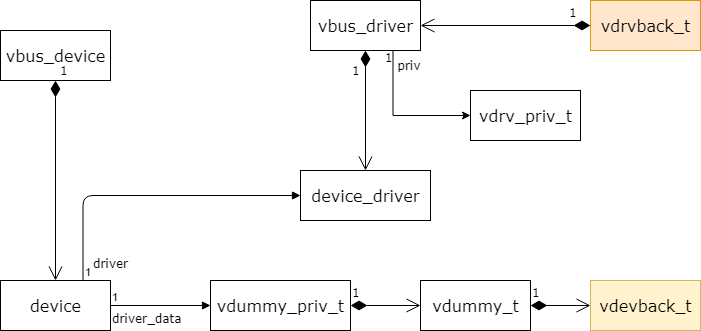2.4. Virtualized interfaces (backend/frontend)¶
The SOO framework has various virtualized interfaces which can be used between the ME and the agency.
On the agency side, these are backends (BE) drivers and can manage several links to MEs which have the
corresponding frontends (FE) drivers. Basically, the backend manage one link for each ME and each FE.
2.4.1. Backends¶
Linux has a well-defined device and driver model in which the basic structures are struct device and struct device_driver.
On top of that, the struct vbus_device structure defined in vbus is used to refer a specific backend device and the
struct vbus_driver refers to a specific backend driver.
As usual in Linux, the association between device and driver is done with a matching mechanism between strings which refer to a device and to a driver. When a matching between device an driver is done, the structures have the references to each other for this spcific binding.

Fig. 2.9 Device and driver model for a backend within Linux¶
In Linux, and in the underlying SOO vbus mechanism which is inspired from the XEN hypervisor (however quite different),
a vbus_device contains the device structure.
Each backend has a private structure which has reference to the vbus definition associated to the device; it contains the ring(s) and other fields required for managing the activities related to the interactions with the frontend.
There is also a private structure attached to the vbus_driver associated to a device. The following helpers can
be used to handle this private structure:
To attach a private structure to a vbus driver
-
void *vdrv_set_priv(struct vbus_driver *vdrv)¶
To get the private structure attached to a vbus_driver
-
void *vdrv_get_priv(struct vbus_driver *vdrv)¶
Finally, a helper to get the private structure attached to vbus_driver from a particular vbus_device
-
void *vdrv_get_vdevpriv(struct vbus_device *vdev)¶
Defining a private structure attached to a vbus_driver can be done in the init function of the driver.
2.4.1.1. VBstore and storage of properties¶
Each backend driver must have a basic entry in vbstore in order to process properties managed by the frontend.
The entries are pre-defined in the file soo/kernel/vbstore/vbstorage.c.
Example of such a entry is:
np = of_find_compatible_node(NULL, NULL, "vdummy,backend");
if (of_device_is_available(np))
vbs_store_mkdir("/backend/vdummy");
As we can see, the entry is created only if the backend is enabled in the device tree.
2.4.2. Frontends¶
SO3 has a slightly different device and driver model. The main structure related to the device is the dev_t structure
which is built during the device tree parsing; as soon as a frontend is detected in the DTS, a corresponding dev_t structure
is allocated and filled with the information from the DTS. The main frontend initialization function is called the private
structure vdummy_priv_t is allocated at this time.

Fig. 2.10 Device and driver model for a frontend within SO3¶
2.4.2.1. VBstore on ME side¶
Each frontend driver must create its own basic entry in vbstore. Properties such as its state will be then added so that
a watch can be attached and trigger a function execution when the state changes.
The entries are created in the file soo/kernel/vbstore/vbstore_me.c.
Example of such an entry is :
fdt_node = fdt_find_compatible_node(__fdt_addr, "vdummy,frontend");
if (fdt_device_is_available(__fdt_addr, fdt_node)) {
DBG("%s: removing vdummy from vbstore...\n", __func__);
vbstore_dev_remove(ME_domID(), "vdummy");
}
Again, we check the device tree (in SO3) to see if the frontend is enabled or not.